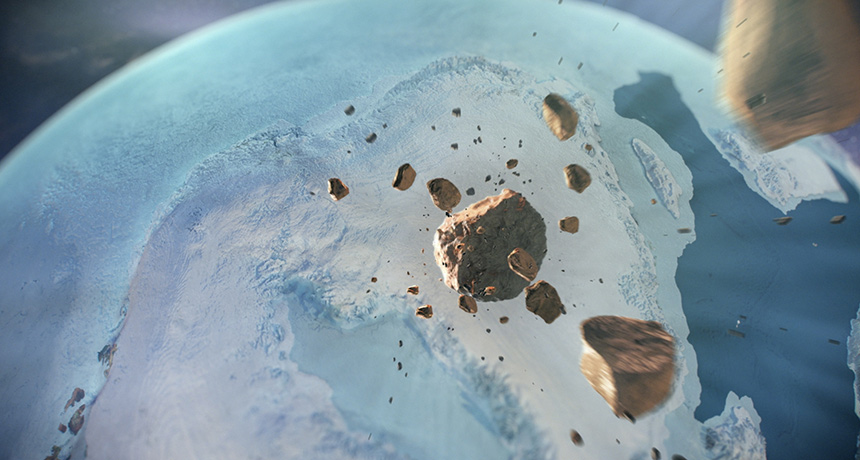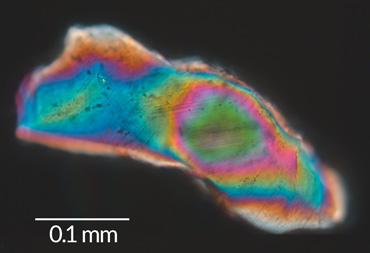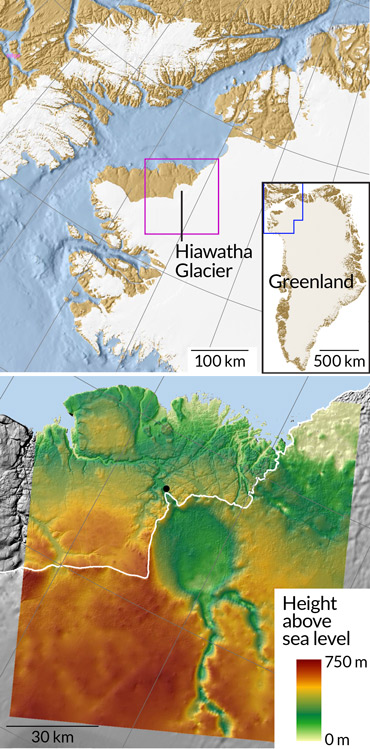
SPACE ROCK An iron asteroid hurtles through space in this artist’s conception of an event that left a large crater in northwest Greenland sometime in the distant past.
Natural History Museum of Denmark, Cryospheric Sciences Lab/GSFC/NASA
There’s something big lurking beneath Greenland’s ice. Using airborne ice-penetrating radar, scientists have discovered a 31-kilometer-wide crater — larger than the city of Paris — buried under as much as 930 meters of ice in northwest Greenland.
The meteorite that slammed into Earth and formed the pit would have been about 1.5 kilometers across, researchers say. That’s large enough to have caused significant environmental damage across the Northern Hemisphere, a team led by glaciologist Kurt Kjær of the University of Copenhagen reports November 14 in Science Advances.
Although the crater has not been dated, data from glacial debris as well as ice-flow simulations suggest that the impact may have happened during the Pleistocene Epoch, between 2.6 million and 11,700 years ago. The discovery could breathe new life into a controversial hypothesis that suggests that an impact about 13,000 years ago triggered a mysterious 1,000-year cold snap known as the Younger Dryas (SN: 7/7/18, p. 18).
Members of the research team first spotted a curiously rounded shape at the edge of Hiawatha Glacier in northwest Greenland in 2015, during a scan of the region by NASA’s Operation IceBridge. The mission uses airborne radar to map the thickness of ice at Earth’s poles. The researchers immediately suspected that the rounded shape represented the edge of a crater, Kjær says.
For a more detailed look, the team hired an aircraft from Germany’s Alfred Wegener Institute that was equipped with ultra-wideband radar, which can send pulses of energy toward the ice at a large number of frequencies. Using data collected from 1997 to 2014 from Operation Icebridge and NASA’s Program for Arctic Regional Climate Assessment, as well as 1,600 kilometers’ worth of data collected in 2016 using the ultra-wideband radar, the team mapped out the inner and outer contours of their target.
The object is almost certainly an impact crater, the researchers say. “It became clear that our idea had been right from the beginning,” Kjær says. What’s more, it is not only the first crater found in Greenland, but also one of the 25 or so largest craters yet spotted on Earth. And it has held its shape beautifully, from its elevated rim to its bowl-shaped depression.
“It’s so conspicuous in the satellite imagery now,” says John Paden, an electrical engineer at the University of Kansas in Lawrence and a member of the team. “There’s not another good explanation.”
On the ground, the team hunted for geochemical and geologic signatures of an asteroid impact within nearby sediments. Sampling from within the crater itself was impossible, as it remains covered by ice. But just beyond the edge of the ice, meltwater from the base of the glacier had, over the years, deposited sediment. The scientists collected a sediment sample from within that glacial outwash and several from just outside of it.
The outwash sample contained several telltale signs of an impact: “shocked” quartz grains with deformed crystal lattices and glassy grains that may represent flash-melted rock. The sample also contained elevated concentrations of certain elements, including nickel, cobalt, platinum and gold, relative to what’s normally found in Earth’s crust. That elemental profile points not only to an asteroid impact, the researchers say, but also suggests that the impactor was a relatively rare iron meteorite.

The ice-penetrating radar data revealed that the crater bowl itself contains several distinct layers of ice. The topmost layer shows a clear, continuous sequence of smaller layers of ice, representing the gradual deposits of snow and ice through the most recent 11,700 years of Earth’s history, known as the Holocene. At the base of that “well-behaved” layer is a distinct, debris-rich layer that has been seen elsewhere in Greenland ice cores, and is thought to represent the Younger Dryas cold period, which spanned from about 12,800 to 11,700 years ago. Beneath that Younger Dryas layer is another large layer — but unlike the Holocene layer, this one is jumbled and rough, with undulating rather than smooth, nearly flat smaller layers.
“You see folding and strong disturbances,” says study coauthor Joseph MacGregor, a glaciologist with Operation IceBridge. “And below that, we see yet deeper, complex basal ice.” Radar images of that bottommost ice layer within the crater show several curious peaks, which MacGregor says could represent material from the ground that got incorporated into the ice. “Putting that all together, what you have is a snapshot of an ice sheet that looked fairly normal during the Holocene, but was quite disturbed before that.”
Those data clearly suggest that the impact is at least 11,700 years old, Kjær says. And the rim of the crater appears to cut through a preexisting ancient river channel that must have flowed across the land before Greenland became covered with ice about 2.6 million years ago.
That time span — essentially, the entire Pleistocene Epoch — is a large range. The team is working on further narrowing the possible date range, with more sediment samples, simulations of the rate of ice flow and possibly cores collected from within the crater.
The date range does include the possibility that the impact occurred near the onset of the Younger Dryas. “It’s the woolly mammoth in the room,” MacGregor says.
HIDDEN TREASURE A newly discovered 31-kilometer-wide crater, long buried underneath Greenland’s ice sheet, may be the remnants of an iron asteroid that struck Earth sometime in the distant past. |
Planetary scientist Clark Chapman of the Southwest Research Institute in Boulder, Colo., notes that “there are plenty of roughly circular landforms on Earth of many different sizes, most of which are not impact craters.” Still, he says, the paper presents several lines of evidence that strongly support the conclusion that the object is a crater, including the shocked quartz and the topography.
As for the idea that a crater may have formed within the last couple of million years, Chapman says, it’s “quite unlikely.” Such strikes are rare in general, he adds, and asteroids barreling into Earth are far more likely to land somewhere in an ocean. “[And] it would be at least a hundred times less likely that it could have happened so recently as to have affected the Younger Dryas.”
Regardless of when the crater formed, it is “a straight-up exciting discovery,” MacGregor says. “And we’re just happy not to have to keep it a secret anymore.”







